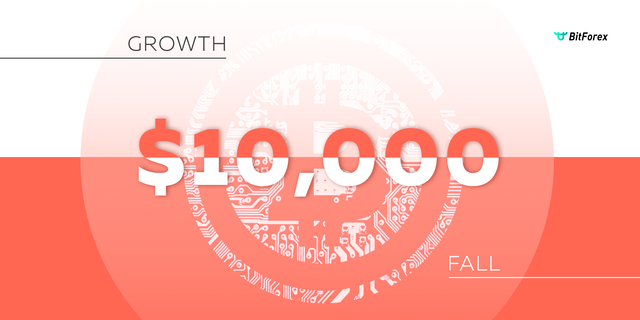Crypto Professionals Provide Estimates of Bitcoin Price Variations After Testing the $10,000 Level Five Times
The price of bitcoin continues to struggle each time it reaches $10,000 resistance, rejecting it and getting back on track at the $8,000–9,000 level. Traders forecast the price of future paths.
Bitcoin fans have witnessed the price test the $10,000 position five times over the last two weeks. Crypto professionals define trading terms as either a bear market or a bull market, depending on the tendency of a price to rise or fall. The $10,000 price level is considered an important emotional point because bitcoin has found it very difficult to break this resistance a few times already. Many traders believe that once broken, the level will become a platform for a stable bullish trend, which is why all traders’ attention has been glued to the chart curves recently.
Crypto masters have pointed out the two main ways to explain the current price position: either the $10,000 resistance is getting weaker and weaker with each effort to reach it, or it is just so strong that traders simply can’t crack it. Still, some traders consider price allocation within $9,000 channel to be grounds for a stable climb to resistance around $14,000–15,000, forming a target point within the $20,000 range. Other bitcoin holders don’t believe such a rapid pump is possible, and they predict a fallback to the $7,000–8,000 range before it can get any closer to breaking the crucial $10,000 resistance.
Bullish Market in the Short-Term
As some of Bitcoin traders claim, the much desired $10,000 resistance level has been made elusive by the multiple price jumps to the $9,800 and $9,900 points. Therefore, breaking this level and turning it into support to rocket to higher positions wouldn’t be a big deal.
The Bitcoin community has split into two groups arguing over whether the current price of bitcoin and its behavior signal an uptrend, giving the bulls credit in providing forecasts based on the supposition that the Bitcoin halving kick-started the bulls’ rally. The Bitcoin halving is an event that takes place every 21,0000 blocks (approximately every four years), where the mining reward is cut in half. It means that the coin supply decreases, fewer coins are paid as a reward for mining, and, therefore, the coin becomes more valuable.
Analyzing the two previous halvings, we can see that both led to a substantial price boost—more than a 2,000% jump. This result is the primary reason why the trading community anticipated the escalation of the price of bitcoin. Therefore, since the May 2020 halving, the market has been expected to be highly bullish, and it did show such tendencies.
As crypto analyst P. Swift points out, a moving average analysis reveals that during the two previous years of bitcoin performance, the lowest price rate was $3,600, and it surged to $5,800, breaking its multi-year support line. By multiplying the average line by five, we will find the next price target to be above $20,000. In the long-term perspective, the price of bitcoin is likely to skyrocket to around $20,000.
“Bitcoin performance has demonstrated extremely bullish trends since it leaped over its 2-year moving average. Such analysis gives a chance to those understanding the market to buy the high-potential asset before the price gets to its all-time high.”
Another Bitcoin trader, N. Bizniz, highlights the candlestick pattern of the short-term and long-term moving average cross, which has only happened six times in BTC history. Such a pattern is considered to be an indicator of a large bullish rally.
“This pattern is called a ‘golden cross’. It happens when a 50-day moving average curve gets across a 200-day moving average line. It’s only the seventh time Bitcoin sees this pattern and the second one with long-term MA line in the uptrend.”
The pattern means that a bullish market is about to be set up. Still, there’s the possibility that the price will start to fall below the cross-level, transforming the trend into a death cross, which is a strong bearish signal.
For the market to keep bullish perspectives and have a chance to retest $10,000, it is essential that the price not fall below $9,000 in the coming week.
One more pattern in favor of a bullish market present on the chart is the triangle known as MACD formed by two moving averages that diverge and converge, forming an upward price direction.
While the price of bitcoin is hovering around $9,000, large crypto investors remain relatively enthusiastic about its future. One top investor claims,
“There are many traders who are shorting Bitcoin just because they are bearishly-minded, and still many are in long positions because they believe in bull market. I feel like I am ready to argue with those who are shorting at this very moment, but time will tell who has been right in this ever-existing competition between longs and shorts.”
Nevertheless, when most traders are bull-minded, there’s always a place for bitcoin price correction before the next spike. It is a risk that bear-market supporters aren’t willing to take.
Bearish Rundown for Bitcoin’s Short-Term Performance
The Bitcoin halving brings on more than just a positive forecast. Many traders support the idea that the Bitcoin halving can lead to a price decline, which is why the current split among bitcoin holders is so evident. The previous two halvings resulted in a price surge, but an instant price downfall that lasted more than ten weeks on average preceded those surges.
This halving wasn’t much different. The struggles to break the $10,000 resistance, especially after a range of similar failures over the last few weeks, coincides with the bears’ expectations of subsequent fall, which triggers many to claim it will be a bearish market. Traders share their ideas of price behavior all over social media, many of them coming down to the prediction that the price will slowly lower to $9,000 before reaching a middle support position in the $8,000–9000 range.
According to bitcoin data analysis, more than 70% of all traders are longing bitcoin at the moment, which indicates that a substantial portion of market players assume that the price will move upwards. It looks like a positive tendency, but it also holds a risk of price collapse because of the astonishingly higher number of longs over shorts.
There are millions of active long positions on the market now. Such substantial contrast in the number of short and long positions leads to the probability of a major price correction.
What Do We Have Left?
The Bitcoin halving has led to its essential characteristics, including the chain-based liquid currency weakening to some extent. As L. Eichholz, a blockchain company executive, noticed, “Bitcoin’s basic principles have modified a little since the halving. The main indicators such as investor sentiment and currency liquidity that along with network health compose a GNI index have experienced the following changes: Bitcoin liquidity faced a slight 2-point decrease, network health was also registered to fall a little over the last week, while the investor sentiment experienced a 14-point increase. In total, the changes has led to Bitcoin GNI weekly fall by 1 point and in total by 73 points.”
The liquidity decline was chiefly triggered by the lowered demand sometime before and after halving. The market performance was quite unpredictable, and traders were simply watching the market move. For example, a little before the halving, the demand rates were increasing.
In the meantime, a minor fall in essential characteristics does not necessarily lead to poor market performance. For instance, there was a rise in the number of addresses holding more than 0.1 BTC, which is definitely a good sign.
It is commonly thought that large investors and whales own most of the available bitcoin. Despite these suppositions, crypto data research reveals that more and more of bitcoin is owned by ordinary traders. Crypto masters point out,
“The number of Bitcoin addresses storing relatively little amounts of Bitcoin has increased by more than 10 percent over a year, which brings us to the conclusion that more Bitcoin is distributed among ordinary people rather than large investors.”
Analyzing the essential bitcoin characteristics, it becomes evident that even major events such as the Bitcoin halving don’t influence the price dramatically in the short-term. Therefore, the only factors that can define the price of Bitcoin in the near future are current price behavior and long-term analysis.
Charts will show a bearish market once the price falls below the $9,000 level and bypasses the golden cross and a bullish market if the price rises above $9600 against a strong resistance, which would mean enough demand to support BTC’s upward trend.


